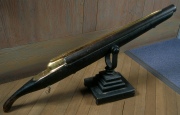Whaling Home | Whaleboats | Next
The Tools
Whaling Guns

Whaling guns were first invented in the 1730s. This followed a prize being offering by the Society of Arts for a successful method of killing whales. Flintlocks were used at this time. These were not very reliable, particularly when wet and it was difficult to avoid water in a pitching open boat. The percussion cap was invented in 1805 and the avoidance of water was not so critical here. By the 1830s more and more guns were in use. Throughout the history of the trade the gun remained more or less the same. It was a muzzle-loading weapon fired by a lanyard. Some had double hammers to lessen the chance of a misfire. Different makers might change the shape of the stock but other than this, little modification was possible.
Harpoons

Harpoons were of two types - fired from a gun or thrown by hand. In either case they served, in the Arctic trade, merely as a way of attaching the boat to the whale. There was never any intention of trying to kill the whale with these weapons. They were always made of good quality iron, designed to bend and twist as the whale tried to escape. Steel could break and the whale would escape. In Scotland, harpoons normally had a twin-barbed head but some American styled single swivel barbs were used. A harpoon, which was thrown, would be mounted on a 2 metre long wooden shaft. This made it a very cumbersome weapon to use.
Each harpoon carried with it a length of rope, usually hemp, called the foreganger. To this would be attached the main whaleline, to which extra lengths could be spliced depending on how far the whale swam from the boat.
Lances
Lances were used to stab the whale until it was dead. Like harpoons they were made of iron so that they were easily sharpened and would twist rather than break. Two or more wood be carried in each boat.